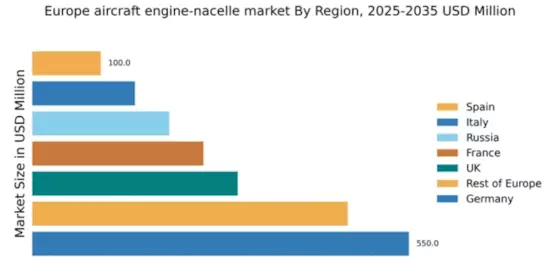Growth of Regional Air Travel
The aircraft engine-nacelle market in Europe is benefiting from the robust growth of regional air travel, which has been fueled by increasing disposable incomes and a rising middle class. As more consumers opt for air travel, airlines are expanding their fleets to meet this demand. This expansion necessitates the procurement of new aircraft equipped with advanced nacelle systems that enhance performance and efficiency. Recent statistics indicate that regional air traffic in Europe is projected to grow by approximately 4% annually over the next five years. This growth trajectory is likely to stimulate demand for innovative nacelle solutions that cater to the specific needs of regional aircraft, thereby providing opportunities for manufacturers in the aircraft engine-nacelle market.
Increasing Demand for Fuel Efficiency
The aircraft engine-nacelle market in Europe is experiencing a notable shift towards fuel efficiency, driven by rising fuel costs and stringent environmental regulations. Airlines are increasingly seeking to reduce operational costs, which has led to a growing demand for advanced nacelle designs that enhance aerodynamic performance. According to recent data, fuel-efficient aircraft can reduce fuel consumption by up to 15%, making them more attractive to operators. This trend is likely to propel investments in innovative nacelle technologies that optimize engine performance while minimizing drag. As a result, manufacturers in the aircraft engine-nacelle market are focusing on developing lightweight materials and advanced aerodynamic shapes to meet these demands, thereby positioning themselves competitively in a rapidly evolving landscape.
Emergence of Electric and Hybrid Aircraft
The aircraft engine-nacelle market in Europe is on the cusp of transformation due to the emergence of electric and hybrid aircraft technologies. As the aviation industry seeks to reduce its carbon footprint, manufacturers are exploring nacelle designs that accommodate electric propulsion systems. This shift is supported by various European initiatives aimed at promoting sustainable aviation, including funding for research into electric aircraft technologies. The potential for electric and hybrid aircraft to reduce emissions by up to 50% compared to traditional jet engines presents a compelling case for investment in new nacelle designs. Consequently, the aircraft engine-nacelle market is likely to evolve rapidly as stakeholders adapt to these emerging technologies, paving the way for a more sustainable future in aviation.
Regulatory Compliance and Emission Standards
The aircraft engine-nacelle market in Europe is significantly influenced by stringent regulatory compliance and emission standards set by aviation authorities. The European Union has implemented rigorous regulations aimed at reducing greenhouse gas emissions from aircraft, which has compelled manufacturers to innovate. For instance, the European Commission's Clean Sky initiative aims to develop technologies that can reduce CO2 emissions by 20% by 2025. This regulatory environment encourages the adoption of advanced nacelle designs that incorporate noise reduction and emission control technologies. Consequently, companies are investing in research and development to create nacelles that not only comply with these regulations but also enhance overall aircraft performance, thereby driving growth in the market.
Technological Integration in Aircraft Design
The aircraft engine-nacelle market in Europe is increasingly shaped by the integration of advanced technologies in aircraft design. Innovations such as digital twin technology and predictive maintenance are becoming essential in optimizing nacelle performance and reliability. By leveraging data analytics and real-time monitoring, manufacturers can enhance the design and functionality of nacelles, leading to improved operational efficiency. This technological integration is expected to reduce maintenance costs and downtime, which are critical factors for airlines. As a result, the aircraft engine-nacelle market is likely to see a surge in demand for nacelles that incorporate these advanced technologies, aligning with the broader trend of digital transformation in the aviation sector.


















Leave a Comment